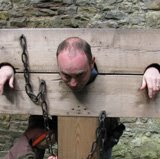[third in a recent series of observations and unfinished semi-coherent thoughts I just need to get out of the way]
Nowadays everyone I talk to questions the metrics they use. More than that, people seem keener to dig into what they may mean in terms of value. Seb Chan is amongst those in our sector that's exploring how to make better, and better use of, measurements, and closer to home, Dylan Edgar's work with the London Hub dug into similar issues.
Last week in a catch-up with the director of my division we touched on his own objective of "improving the website". In itself it's encouraging that the objective is there, as part of the reorganisation we are currently experiencing, but "improving the website" is a pretty broad ambition. I think it's a subject that we'll revisit in more depth soon, but it was clear that our director was as aware as we web types were that when you lift up that rock you'll find a tangled mess of questions. Before you talk about "improving" you need to identify what you consider to be valuable, and to disentangle theoretical "improvements" from impact, preparedness, experimentation etc. Obviously a set of measurements that to some degree reflect these valued qualities are a sine qua non for managing their realisation, and so here's a reference to provoke a little more thought on the subject that I won't dig into here, but has had me rethinking my own attitudes web stats and the whole evaluation problem: Douglas W Hubbard, 2007, How to measure anything : finding the value of "intangibles" in business. *
In any case I find it encouraging that in this discussion and others with senior colleagues there seems to be a dawning awareness that we have a complex, multidimensional environment to deal with, wherein the varieties of "success" may be as varied as between all the departments within a museum. I'm not sure that it would always have been the case that the higher echelons were aware of the perils of trying to evaluate our digital programmes, although perhaps any senior manager worth their salt will have long ago twigged that a website is not "improved" merely by adding pages, Flash splashes and video - evaluating the more familiar physical museum is no easier, after all, and nor is improving it. We do need to have that conversation about what we mean by "website" with senior management, though. Is it only geeks that see this as only a part of our digital presence?
When it comes to the use of web stats of various sorts, there have always been lots of complaints about them, but I suspect that in this discussion too we are seeing greater recognition that it's not about visitors versus hits. Maybe it's not even enough to focus on "impact" since the heart of the matter arguably lies a level deeper than that: the first step is figuring out what impact itself means in the context of the museum's mission, and in this networked environment in the mission of the meta-museum that we must realise we are a part of.
Rhetorical question for the day, then: Is there a mission for the meta-museum, and do we measure up to it?
*I hope to post about this book properly, eventually, but don't wait for that, try to check out the book which, for all its flaws of repetition, is full of useful ideas and tools.

No comments:
Post a Comment